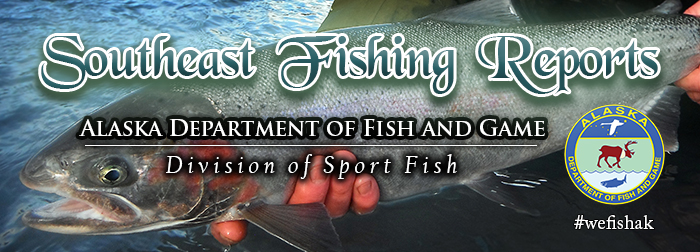
|
||
|
Kelly Reppert, Area Management Biologist (907) 225-2859, kelly.reppert@alaska.gov |
Area Sport Fishing Reports
Ketchikan
October 6, 2025
Freshwater Salmon
Fall coho are returning to freshwater in full force throughout the Ketchikan area. Fishing is good now and will start to slow down toward the end of October. The use of bait is allowed from September 15-November 15, be sure to check current regulations as bait is prohibited in some systems.
Saltwater Salmon
Coho
Marine coho fishing is tapering off in the Ketchikan area. Anglers looking for late-season opportunities may want to concentrate efforts closer to Neets Bay.
Chinook
As we move through fall and head into winter, anglers will have the chance to target winter king salmon. Starting October 1 through March 31, a resident angler may use two rods when fishing for king salmon, a person using two rods under this regulation may only retain salmon.
- Resident anglers: Bag and possession limit is one king salmon; 28 inches or greater in length.
- Nonresident anglers: Bag and possession limit is one king salmon; 28 inches or greater in length. Annual limit of one fish.
Halibut
Halibut fishing will continue to be good into the fall.
Lingcod
- Residents: one fish per day; two in possession; no size limit.
- Nonresidents: one fish per day, one in possession, size limit 30 – 35 inches in length or 55 inches or greater in length. Annual limit of two fish, one of which is 30 to 35 inches in length, one of which is 55 inches or greater in length, a harvest record is required.
- Season: May 16 - November 30
Rockfish
Rockfish can be caught year-round. Stop by the Fish & Game office or visit the website for resources on identifying rockfish species. All sportfishing vessels are required to have at least one deep water release device on board.
Slope Rockfish
- Resident and nonresident anglers:
- Daily bag limit of one fish; possession limit of two fish; no annual limit
Demersal Shelf Rockfish
Demersal shelf rockfish are the following species: yelloweye, quillback, canary, China, copper, tiger, and rosethorn.
- Resident anglers: Daily bag limit of one fish including yelloweye; possession limit of two fish; no annual limit.
- Nonresident anglers: Season is closed.
Pelagic Rockfish
Pelagic rockfish species include black, dark, dusky, widow, and yellowtail.
- All anglers: three per day; six in possession.
Trout and Dolly Varden
There are a variety of lakes and rivers with good trout fishing in the Ketchikan area. When fishing lakes, concentrate your efforts near the inlet and outlet, where fish tend to congregate. As salmon are spawning in the creeks and rivers, trout tend to stack up behind the salmon, feeding on eggs flowing downstream.
Interactive Fishing Location Maps
An excellent resource for planning a trip is the gofishak interactive map for Ketchikan which provides information on popular fishing locations, species run timing, fishing gear selections and boat and angler access.
Thank You to Participants and Creel Staff
Thank you to all the anglers who participated in the marine creel program this season. Your participation is very important and much appreciated. Creel surveys are one of the most commonly used fishery management tools by the Alaska Department of Fish and Game to determine harvest in recreational fisheries. The information collected through these surveys helps us make informed management decisions and keeps us aware of the overall health of the fisheries throughout Southeast Alaska.
Thank you to all the creel staff for your hard work and dedication throughout the season.
